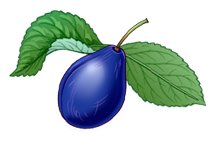
History
The word “powidło” [plum with very little or no sugar converted into a thick brown paste / spread] has been known in Polish since the 15th century. It comes from the combination of the verb “powić” – in the meaning of rotation, with a suffix – “dło” and initially it meant a tool for mixing. Currently in use it is most often in plural.
The jam is made by frying the fruit for a long time. Classical jam is made without the addition of any sugar or spices. It can be made from various kind of fruit, but plums, especially prune plums (Prunus domestica domestica), are the best for this purpose. Plums for jamming should be very ripe and even overripe (“wrinkled”), because then they are the sweetest then.
“Plum jam” is one of the oldest preserves of traditional Polish cuisine. Recipes for them can be found, for example, in the farmbooks of Piotr Crescencyn (1549) and Jan Jakub Haur (1675). In Polish cuisine, the jam has also had various uses for a long time. Stefan Czernicki, the author of the Compendium Ferculorum or the Collection of Dishes from the first Polish cookbook of 1682, lists them among the products needed for a banquet, recommends fried dumplings with jam, and also gives recipes for meat and fish dishes with jam.
In the past, plum jam used to be made mainly for own use. The owners of large orchards also made them for sale. Smaller quantities of jam were made in copper saucepans or bowls. Larger portions were made in multi-litre cauldron made of copper sheet. Making large amounts of jam required a lot of treatment.
Prior to their use, the cauldrons were carefully cleaned (e.g. with oxalic acid with sand) and spread with fresh butter so that the fruit would not burn during frying. A vessel into which washed plums with stones were thrown, was usually placed on the hearth in the orchard and the jam was made here. Large, wooden ladles or special wooden stirrers were used to mix the jam. When the plums turned into mash, they were ground through sieves or strainers in order to separate the stones. The ground mass was cooked again. Depending on the amount of fruit, it took 3 to 10 hours to make the jam.
Making of the jam lasted until the mass thickened sufficiently. Boleslaw Kasprowicz in his household handbook Wyrób marmelady i powideł (Marmalade and Jam Making) recommended that they should be cooked for such a long time „that behind the ladle, which the jam is mixed with, there is a visible trace of a cavity and the jam will stand evenly on both sides of the ladle”.
The finished jam was put into wooden barrels, stoneware pots and protected against spoilage. Most often the vessels with the jam were placed in a bread oven or stove and baked. A shell was then formed on their top, which protected them from mildew. For conservation purposes, it was also recommended – after baking the jam – to pour wax, fresh butter or tallow over it, to cover it with “crushed” pepper, or to cover it with parchment paper soaked in spirit or rum. At the turn of the 19th and 20th century, when the use of glass jars for storing preserves was widespread, the use of cellophane (so-called glass paper) was recommended to protect the jam from mould and spoilage, which, after being moistened with water, the jars were wrapped with.
Plum jam was also made with various “seasonings”. Old cookbooks recommended to add to the jam e.g. elderberry juice, green walnut shells, spices (e.g. cloves, cinnamon, coriander), as well as lemon or orange peel in order to get “indulgent flavour”. Well cooked and protected jam could be stored supposedly several or even over a dozen years.
On the territory of the present-day Kujawsko-Pomorskie Province, especially in the Lower Vistula Valley region, making plum jam has a few centuries’ tradition. For this purpose, mainly prune plums grown in domestic orchards were used. The Olender settlers also made it from damson plums. Information on making the jam in the area is confirmed by historical and ethnographic sources. The collection of the Ethnographic Museum in Toruń also includes early twentieth-century monuments related to making plum jam – copper bowls and cauldrons and stirrers. The process of making and preserving jam in our region was the same as in other parts of Poland. Copper „kuprowe” cauldrons (from Latin cuprum – copper) and wooden stirrers called locally “bociany” [“storks”] were also used here. Clay strainers, made by local potters, were used to grind the jam. The plum jam produced in this region was used for its own needs as well as for sale. I was mostly sold at nearby marketplaces.
Plum trees have been cultivated in Poland for several hundred years, which is confirmed by both archaeological excavations (including those from Gruczno in the Kujawsko-Pomorskie Province) and written sources from the 12th century. Information about plum trees and their cultivation can also be found in the first Polish books about plants from the 16th century and farmhouse guidebooks from the 17th century. Plum trees were grown in the so-called fruit gardens together with other tree species or plum orchards called “śliwnik” (plum tree gardens) were established. Damson plums and prune plums were mostly grown there.
Plums were already appreciated in the past for both their healing and taste qualities. They were regarded as a fruit with “cooling and softening power” and “not fattening enough”. They were used – both fresh and dried – for constipation and in diseases with fever, as a thirst-relieving agent. However, moderation in eating them was recommended, especially for people with a delicate stomach.
Modern research has confirmed the health properties of plums. Plums contain a lot of minerals, vitamins and fibre, thanks to which they have, among other things, anti-inflammatory and calming properties and can be used in slimming diets.
The most popular plums in Poland – for generations – have been prune plums, which taste great when eaten fresh and, most importantly, are excellent for preserves.
Prune Plum (Prunus domestica domestica). A prune plum tree is small. It grows fast and is frost-resistant. The leaves are medium sized, have an oblong shape and serrated edges. The flowers are not too big and have a white-greenish colour, they develop in early May, together with the leaves. The fruit is oblong, dark purple, with a light wax coating, ripens in late September. The stem is flattened and stands out easily from the flesh, which is characterised by a yellowish green colour, firmness, juiciness and a sweet or sweet-spicy taste.
The prune plum is a variety of a garden plum, which probably comes from the Caucasus and Asia Minor. It was formed in natural conditions, as a result of the crossbreeding of sloe and “ałycza” (cherry plum tree). From the region where it was developed, it first spread in neighbouring countries, then in the Mediterranean region, from where it reached Western and Central Europe. It most probably came to Poland from Hungary (hence its name). In Europe it gave rise to many varieties, e.g.: sugar prune plum, early prune plum, late prune plum, Italian prune plum.
With time, when the prune plum tree began to spread in Poland, and when its multiple uses were appreciated, special attention was paid to the favourable climatic conditions of particular regions of the country and to the proper selection of land for its cultivation. Polish agricultural and horticultural guidebooks recommended the cultivation of these plum trees on hillsides or in river valleys, for example, on fen soils in the Vistula valley and on the Vistula terraces.
Agricultural and horticultural farms were established, specialising in both the production and sale of seedlings of new prune plum varieties. For example, the Toruń-based gardening company G. Hentschel’s offer for 1938/1939 included seedlings not only of a prune plum tree, but also of new prune plum varieties – e.g. Wangenheim and Bühlertal.
Very good natural conditions (soil, climate) caused that fruit growing, including plum tree growing, became popular especially in the Lower Vistula Valley (from Bydgoszcz to Nowe). Fruit orchards, in which plums were mostly grown, were most often established here by the Olenders – settlers from Western Europe. They were also most often engaged in trade and processing of fruit. Cultivation and processing of fruit in the Lower Vistula Valley was also supported by the Prussian authorities, seeing in this the development and benefits for local farms. Fruit-growing traditions, initiated by the Olenders, have survived in this area until today.
Prune plums have long been used in Polish cuisine in various ways. They are suitable for compote, soup (“śliwczanka” garus śliwczany), cakes and dumplings. Dishes made of dried plums have been served for generations on Christmas Eve. Prune plums have proved their worth in processing. They can be dried, made into tinctures and vodka (plum brandy). Prune plums have long been regarded as the best fruit for making plum jam.
Historical objects
The historical objects come from the collections of the Maria Znamierowska-Prüfferowa Ethnographic Museum in Toruń (MET) and the National Museum of Agriculture and Agro-Food Industry in Szreniawa (MNR).


